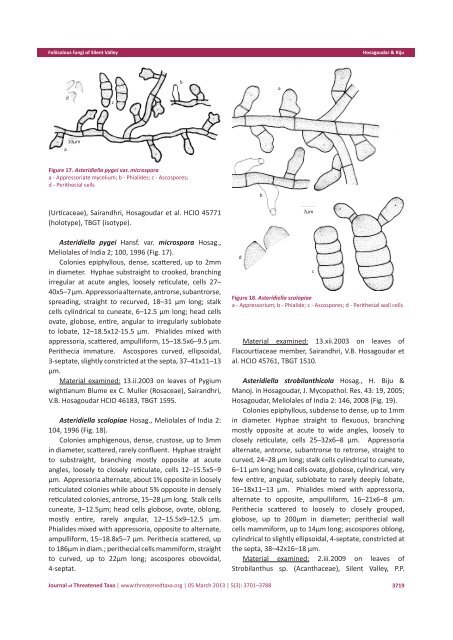PDF - Journal of Threatened Taxa
PDF - Journal of Threatened Taxa
PDF - Journal of Threatened Taxa
Create successful ePaper yourself
Turn your PDF publications into a flip-book with our unique Google optimized e-Paper software.
Foliicolous fungi <strong>of</strong> Silent ValleyHosagoudar & Rijudcbaa10µmFigure 17. Asteridiella pygei var. microsporaa - Appressoriate mycelium; b - Phialides; c - Ascospores;d - Perithecial cellsb(Urticaceae), Sairandhri, Hosagoudar et al. HCIO 45771(holotype), TBGT (isotype).Asteridiella pygei Hansf. var. microspora Hosag.,Meliolales <strong>of</strong> India 2; 100, 1996 (Fig. 17).Colonies epiphyllous, dense, scattered, up to 2mmin diameter. Hyphae substraight to crooked, branchingirregular at acute angles, loosely reticulate, cells 27–40x5–7 µm. Appressoria alternate, antrorse, subantrorse,spreading, straight to recurved, 18–31 µm long; stalkcells cylindrical to cuneate, 6–12.5 µm long; head cellsovate, globose, entire, angular to irregularly sublobateto lobate, 12–18.5x12-15.5 µm. Phialides mixed withappressoria, scattered, ampulliform, 15–18.5x6–9.5 µm.Perithecia immature. Ascospores curved, ellipsoidal,3-septate, slightly constricted at the septa, 37–41x11–13µm.Material examined: 13.ii.2003 on leaves <strong>of</strong> Pygiumwightianum Blume ex C. Muller (Rosaceae), Sairandhri,V.B. Hosagoudar HCIO 46183, TBGT 1595.Asteridiella scolopiae Hosag., Meliolales <strong>of</strong> India 2:104, 1996 (Fig. 18).Colonies amphigenous, dense, crustose, up to 3mmin diameter, scattered, rarely confluent. Hyphae straightto substraight, branching mostly opposite at acuteangles, loosely to closely reticulate, cells 12–15.5x5–9µm. Appressoria alternate, about 1% opposite in looselyreticulated colonies while about 5% opposite in denselyreticulated colonies, antrorse, 15–28 µm long. Stalk cellscuneate, 3–12.5µm; head cells globose, ovate, oblong,mostly entire, rarely angular, 12–15.5x9–12.5 µm.Phialides mixed with appressoria, opposite to alternate,ampulliform, 15–18.8x5–7 µm. Perithecia scattered, upto 186µm in diam.; perithecial cells mammiform, straightto curved, up to 22µm long; ascospores obovoidal,4-septat.d7µmcFigure 18. Asteridiella scolopiaea - Appressorium; b - Phialide; c - Ascospores; d - Perithecial wall cellsMaterial examined: 13.xii.2003 on leaves <strong>of</strong>Flacourtiaceae member, Sairandhri, V.B. Hosagoudar etal. HCIO 45761, TBGT 1510.Asteridiella strobilanthicola Hosag., H. Biju &Manoj. in Hosagoudar, J. Mycopathol. Res. 43: 19, 2005;Hosagoudar, Meliolales <strong>of</strong> India 2: 146, 2008 (Fig. 19).Colonies epiphyllous, subdense to dense, up to 1mmin diameter. Hyphae straight to flexuous, branchingmostly opposite at acute to wide angles, loosely toclosely reticulate, cells 25–32x6–8 μm. Appressoriaalternate, antrorse, subantrorse to retrorse, straight tocurved, 24–28 μm long; stalk cells cylindrical to cuneate,6–11 μm long; head cells ovate, globose, cylindrical, veryfew entire, angular, sublobate to rarely deeply lobate,16–18x11–13 μm. Phialides mixed with appressoria,alternate to opposite, ampulliform, 16–21x6–8 μm.Perithecia scattered to loosely to closely grouped,globose, up to 200μm in diameter; perithecial wallcells mammiform, up to 14μm long; ascospores oblong,cylindrical to slightly ellipsoidal, 4-septate, constricted atthe septa, 38–42x16–18 μm.Material examined: 2.iii.2009 on leaves <strong>of</strong>Strobilanthus sp. (Acanthaceae), Silent Valley, P.P.<strong>Journal</strong> <strong>of</strong> <strong>Threatened</strong> <strong>Taxa</strong> | www.threatenedtaxa.org | 05 March 2013 | 5(3): 3701–37883719

















